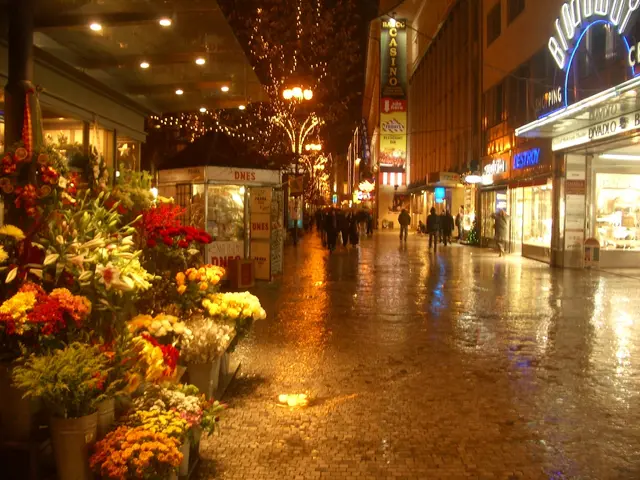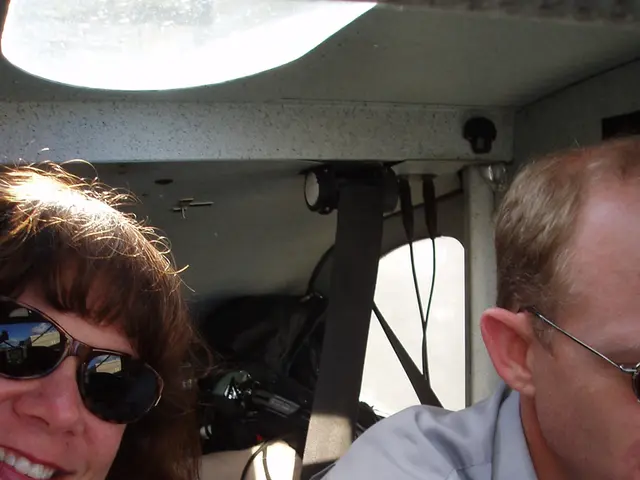Exploring Colorado Mountains: A Comprehensive Guide for Mountain Hikers
Colorado's outdoor playground is no exaggeration! With over 17,000 trails coasting a whopping 39,000 miles, hiking here is like taking a stroll around the planet 1.5 times. That's one hell of a hike!
This heavenly destination offers a wealth of navigational advice, such as which trails to choose, stuff to bring, what to don, scenic drives, and exploration tips to make the most out of your Rocky Mountain adventure. You'll find everything you need to secure a thrilling, safe wilderness adventure right here.
Chasing Altitude Sickness
Altitude sickness, or acute mountain sickness, can put a damper on your Colorado hiking fun. This condition strikes everyone differently, with elderly, overweight, and those with heart conditions being more susceptible. If you tick any of these boxes, get the green light from your physician before hitting the trails.
Symptoms are similar to a hangover, and can usually be self-treated with painkillers like Ibuprofen and Acetaminophen, subsiding within 24-48 hours. Ease the pain with plenty of H2O and simple carbs like bread and pasta.
But what's the big deal with altitude sickness? Well, some of the best hikes are high up, and altitude can spoil the fun. Be attuned to your body, and if you're not feeling well, skip high-elevation hikes. Acclimate and hydrate before attempting any treks. Try an easy hike or exploring Colorado's picture-perfect mountain towns for a less strenuous start.
Timing is Everything
Hiking in Colorado is a year-round activity, but the excitement varies based on the season. In the winter (December-March), hiking involves snow transportation gear, such as snow shoes, cross-country skis, or backcountry equipment. In the summer (late June-September), you'll enjoy conventional summer hiking.
During the shoulder seasons (April-May and October-November), there's not enough snow for snowshoeing or skiing, but it's too early for regular hikes. While winter exploring is adventurous, our favorite season is early summer through late fall, with its vibrant wildflowers, abundant wildlife, and spectacular fall colors.
Summer Magic
The summer scene at high elevations typically kicks off mid-June through August, depending on snowpack. Heavier snowfall may delay the start to July. Check local conditions to see what's happening in your preferred area. Summer's the best because life abounds, with wildlife, wildflowers, green aspens, alpine lakes, and roaring waterfalls showcasing their splendor. Peak wildflower season in higher elevations (above 9,500 feet) is mid-late July, while lower elevations may bloom earlier.
Autumn Splendor
By mid-August, things start to turn brown, and September brings less green and more fall colors. Peak foliage usually falls late September and the first week of October. Fingers crossed for a leaf-peeping extravaganza!
Frosty Delights
Perhaps the most important season in the mountains is winter, thanks to Colorado's 32 ski resorts. Winter's not just for hotshots on the slopes: snowshoeing, cross-country skiing, and winter hiking offer alternative mountain frolics.
When the Best Time is the Time to Hike
While hiking in the afternoon is possible, the morning is the best time for a hike, with a few exceptions. Weather forecasts should always be consulted, and it's essential to be prepared for rain, even on days with no forecasted precipitation. Rain falls almost every day in the summer, so always carry rain protection like a rain jacket and quick-drying clothing. Afternoon thunderstorms are frequent, with lightning posing a real danger. Safe hiking practices are crucial for high-elevation treks, especially long hikes like 14ers, which may require early morning starts.
Intense sun and dehydration are other risks, with elevation magnifying the Sun's rays. Wear long-sleeved, dry-fit, UPF-rated shirts and sunscreen on all exposed body parts, including the back of your hands, an often-forgotten sunburn spot.
Good Things Come to Those Who Hike
Colorado's hiking variety is truly sigh-worthy, with beautiful vistas around every corner. With trails everywhere, each has its own charm. The mountains are separated by location, so it all comes down to personal preference when choosing where to go next.
The North
The northern mountains encompass areas like Steamboat, Rocky Mountain National Park, Breckenridge/Keystone, Loveland, Vail, etc., and is the area many are most familiar with. This region has a long winter season with a short, beautiful summer season. Its proximity to Denver, home to the main international airport, makes it a popular destination. Enjoy plenty of established trails and family-friendly activities.
The South
The Southern Mountains are more challenging and rewarding, earning the nickname "Switzerland of America." Favorite towns like Telluride, Ouray, Silverton, Wolf Creek, and Purgatory offer rugged hiking trails, bright blue water, and numerous other adventures. Due to their remoteness, they tend to be less crowded, making for a more secluded hiking experience.
The Central
The central mountains include Aspen, Monarch, and Crested Butte, with a slightly longer summer season due to their lower elevation. Aspen is known for its breathtaking autumn colors, while Crested Butte boasts the state's largest wildflower festival. Both are beautiful hiking destinations. The area between Crested Butte and Aspen is called the Maroon Bells-Snowmass Wilderness, and is known for Maroon Bells Scenic Area (the most photographed spot in Colorado), Crystal Mill, and the Four Pass Loop (the best multi-day backpacking trip in Colorado).
The West
The west features borderline desert climates, with more dirt and red rock than trees. Popular areas like Grand Mesa, Fruita, Palisade, and Colorado National Monument are brimming with hiking opportunities. Spring is the best time to visit due to milder weather and less crowds.
25 and I-25
Colorado's highway I-25 runs from north to south, connecting major towns like Fort Collins, Boulder, Denver, Colorado Springs, and Pueblo. These cities may seem small, but they're densely populated and still offer ample hiking and outdoor recreation opportunities.
The National Parks and Monuments
Colorado is home to one of the top 10 most visited national parks, Rocky Mountain National Park, which offers stunning mountain vistas, abundant wildlife, and beautiful alpine lakes. Mesa Verde National Park, Great Sand Dunes National Park, and Black Canyon of the Gunnison National Park showcase unique landscapes, from ancient cliff dwellings to vast sand dunes and rugged canyons. venture into the outdoors and explore Colorado's many National Monuments, National Recreation Areas, and National Forests.
Dressing for Success
Weather in the mountains can be unpredictable, so layers are crucial when hiking in Colorado. Wear lightweight, waterproof clothing that can be removed or added as needed. A hat, gloves, and neck gaiter are also important to prevent sunburn and windburn.
Special Adventures
In the winter, hiking turns into a whole new adventure. Winter hiking is beautiful in its own way and requires different gear, such as waterproof clothing, boots, and traction devices. Look into snowshoeing, cross-country skiing, and backcountry skiing for winter exploration options.
When hiking Colorado's mountainous terrain, a few considerations become essential:
- Mud Season: Springtime in the mountains can be a messy affair, with trails turning into sea of mud. To avoid getting stuck in mud, it's best to avoid mud season altogether and wait until late June to visit.
- Avalanche Danger: Avalanches can be fatal in the mountains, so it's crucial to check local avalanche reports and listen to local advice when planning your winter hike.
- Trail Access: Many trails require a short drive on a dirt road, which may not be plowed in the winter. Be prepared for additional travel time and potential snow tires or chains.
Proper Packing Makes Perfect Hikes
Pack essentials to ensure a safe and comfortable hiking experience. Here's a guide on what to pack for a day hike or a multi-day backpacking trip in Colorado:
Day Hikes
Clothing
- Multi-layered clothing to accommodate changing temperatures and weather conditions
- Rain jacket
- Hiking boots or trail runners
- Sun-protective clothing, including hats, sunglasses, and long-sleeved shirts
Hydration/Food
- Water and a filtration system (such as a water bottle or hydration pack)
- Snacks to keep energy levels up
- Packable lunch options like sandwiches or energy bars
Electronics
- GPS device, such as an all-terrain map or smartphone with a trail-tracking app
- First-aid kit
- Light source, such as a headlamp or flashlight
Misc. Gear
- Hiking poles
- Camera to capture memories
- Bear spray if hiking in areas with bear activity
Backpacking
For multi-day backpacking trips, increase the amount and type of gear you bring, focusing on durable and lightweight items to reduce backpack weight. Always pack enough food, water, and clothing to last the duration of your trip.
Gear
- Tent or shelter
- Sleeping bag and pad
- Cookware and food supplies
- Stove and fuel
- Navigation tools
- Bear canister for secure food storage
- Multitool
- Emergency shelter
Clothing
- Multi-layered clothing for varying temperatures
- Rain gear
- Insulating outer layers
- Hiking boots
- Sun-protective clothing, including hats, sunglasses, long-sleeved shirts, and lightweight gloves
Backpack
- A durable, comfortable backpack with sufficient storage capacity for your trip
With this guide, you're all set! Happy hiking!
- Over 17,000 trails coasting a whopping 39,000 miles make hiking in Colorado an expansive journey equivalent to strolling around the planet 1.5 times.
- Navigational advice in Colorado includes tips on which trails to choose, stuff to bring, what to wear, scenic drives, and exploration strategies to ensure a thrilling, safe wilderness adventure.
- Altitude sickness, or acute mountain sickness, can impact hikers by causing similar symptoms to a hangover, and those elderly, overweight, or with heart conditions need medical clearance before hitting the trails.
- Hiking in Colorado is a year-round activity, with winter hiking requiring snow transportation gear like snowshoes, cross-country skis, or backcountry equipment.
- During the shoulder seasons (April-May and October-November), there's not enough snow for snowshoeing or skiing, but it's too early for regular hikes. Summer (late June-September) offers the best conditions for wildlife, wildflowers, and vibrant colors.
- The North region, including popular towns like Steamboat, Rocky Mountain National Park, Breckenridge, Loveland, Vail, offers a long winter season and established trails, while the South, known as "Switzerland of America," features rugged trails with less crowds.
- The central mountains, such as Aspen and Crested Butte, boast a longer summer season due to their lower elevation, with Aspen famous for breathtaking autumn colors, and Crested Butte known for hosting the state's largest wildflower festival.
- Colorado's hiking variety offers beautiful vistas around every corner, and it's essential to pack layers, waterproof clothing, hats, gloves, and neck gaiters to accommodate unpredictable weather.
- Winter hiking needs different gear like waterproof clothing, boots, and traction devices, and backpackers should be aware of mud season, avalanche danger, and trail access during the winter months for a safe and comfortable hiking experience.








